Dark Skies: Volcanic Contribution to Climate Change
A volcanic eruption can affect global climate for several years. Students explore recent and historical videos and create a simple volcano model to learn about atmospheric change that causes a reduction in light to Earth’s surface and how this affects climate.
Learning Objectives
- Recognize that volcanic eruptions, a process of the geosphere, can affect the composition of the atmosphere
- Understand the impact of large volcanic eruptions on environments as well as climate
- Summarize how volcanic eruptions, a natural event, contributes to climate change
Materials
- Online article: How Volcanoes Influence Climate
- Computer with Internet access
- Projector
- 1 box of baking soda
- 1 bottle of white vinegar
- 1 small bag of flour
- Snack sized ziplock bags (3 per group)
- Permanent markers to label bags
- White copy paper (3 pieces per group)
- Flashlights (1 per group)
- Safety glasses (for each student)
- OPTIONAL: Light meters
- Metric rulers
- Science notebooks
- Pencils
Preparation
- Preview the videos linked from step 1 of the directions below; identify sections that are visually engaging to share with students during the activity (you will want to mute the sound in the videos to allow students to come up with their own explanations).
- Write on the board or project the questions for the launch. You might also type the questions up for students.
- Prepare the volcano model materials. Each group of three students will need:
- A small beaker of vinegar
- About 3 tsp of baking soda
- About 3 tsp of flour
- Make copies of Volcanic Eruption Protocol - Student Page and Volcanic Eruption, Climate Disruption page (one set per group)
- Make copies of Volcanic Eruption: Sequence of Events (one set per group). Cut out the squares and put each set together in a paperclip or envelope.
- Gather materials that students might need to make their fact sheet (paper, colored pencils, markers, etc) unless they will create a digital fact sheet. Print a copy of the Assessment Rubric for each group.
Directions
Launch: Observations About Volcanic Eruptions
(Note: Students should notice that during an eruption lava spreads across the land, while ash becomes part of the atmosphere.)
- Project the videos of massive volcanic eruptions. Initially, keep the sound muted to allow students to form their own ideas. Ask students to record at least five observations as they watch the videos in their science notebook.
- After watching, direct students to discuss the following questions with a partner, using the observations they recorded in their science notebooks to help them:
- What was the event that was occurring?
- What do you think happens during a volcanic eruption? What would it feel and sound like if you were close by?
- What materials are forced out of a volcano? Where do they go?
- Are all eruptions the same? How are they similar and different?
- Replay one of the videos. Draw student attention to the vast amounts of ash and gas that are forced into the atmosphere during explosive eruptions. Ask students to consider where that material goes and what effects it might have upon the planet.
- Ask students what changes they would predict for the landscape and atmosphere over time after an eruption. Create class list on the board of student ideas.
Investigate: Particles Matter
Part 1: A Volcanic Eruption
- In this investigation, students will explore the effects of a volcanic eruption on the atmosphere by creating a simple model. Assign students to groups of 3.
- Give each group a copy of the Volcanic Eruption Protocol - Student Page and have each group collect the materials for the volcano model.
- Instruct each group to read through the steps on their students pages and follow instructions for Part 1. Remind students to wear safety glasses and follow safety protocols.
- Students will create three different experiments: a control (just baking soda), a volcano that spews gas (baking soda + vinegar), and a volcano that spews gas, ash, and rock particles (baking soda + vinegar + flour). They will record observations for each eruption in the table for Part 1 on the student page.
- Hold a class discussion at the end of this investigation, using the following question prompts:
- What variable did you change?
- How does this model represents a volcanic eruption?
- What are the limitations of our model? How could we modify the model to test other ideas and predictions about volcanic eruptions?
Part 2: The Sunlight
- Explain to students that they will model light reaching Earth following a volcanic eruption. The flashlight represents the Sun, the white paper represents the surface of the Earth, and the three ziplock bags the atmosphere in different conditions - "normal" atmosphere, with a volcano spewing gas, and with a volcanic explosion. Optional: If a light meter is available, students might use this to detect the amount of light shining through the bags.
- Instruct students to follow the directions for the sunlight investigation and then answer the questions on their student page for Part 2.
Develop: Global Effects
- Still in their groups of three, ask students to read the short article How Volcanoes Influence Climate. Have students take turns playing each of the roles, switching after each paragraph:
- Reader: This student reads the paragraph aloud.
- Annotator: This student points out any phrases that are unfamiliar, and points out any questions they have about the paragraph.
- Summarizer: This student summarizes the paragraph.
- Give each group a copy of the Volcanic Eruption, Climate Disruption page. Explain the illustrations at the top that show what the Sun looked like before, during, and at several times after an eruption. Explain the axes of the graphs and the student directions.
- Ask students to follow the directions on the page to draw a graph of the relative amount of ash in the atmosphere based on the illustrations of the Sun. Then, use what they learned about how volcanoes influence climate from the article they read to draw how the temperature at the Earth's surface changes due to a large eruption.
- Summarize results as a class.
- Amount of volcanic debris: Large amount of ash right after the eruption and then amount of ash decreases gradually over time.
- Temperature curve should be the inverse of the ash curve - i.e., when the ash amount is greatest, temperature is lowest, when the ash amount is lower, the temperature is higher.
- Hand out the squares from the Volcanic Eruption: Sequence of Events. Ask students to work in their groups to arrange the squares in the order that the events take place. Then, compare their sequence with another group.
- Review the answers as a class. Record the events, in order, on the board.
Assessment
Ask students to create a one-page fact sheet informing the community about how volcanoes impact climate. Encourage creativity, including using comics, cartoons, color, poetry, slogans, and so on to capture the audience’s attention and educate their community. Share the Assessment Rubric with students prior to creating their fact sheets, and to assess student understanding.
Extensions
- Create a set of images that show the sequence of events, in the Earth’s atmosphere during and after a volcanic eruption.
- Describe the impact of volcanic eruptions both regionally and globally.
- Create a hypothesis about how volcanic eruptions impact other parts of the Earth system (biosphere, hydrosphere, cryosphere, geosphere).
- Investigate what causes volcanoes and where volcanoes are located in their country or state.
- Explore how different materials that spew into the atmosphere stay aloft for different amounts of time, by creating a model with sediment of various sizes settling in a jar of water. Observe how larger, heavier particles settle to the bottom of a jar before smaller, lighter particles.
Background

A gas plume arising from Augustine Volcano during eruption in 2005-2006.
USGS
Scientists who specialize in the study of climate (climatologists) have identified three major contributors to climate change: the solar cycle, extreme or persistent volcanic eruptions, and the release of heat-trapping gases into the atmosphere, largely as byproducts of burning fossil fuels.
Volcanoes can have a significant long- and short-term effect on the global climate and environment. All volcanoes are different; some spew ash and gases while others have eruptions that are mostly lava. Very explosive volcanic eruptions can send tiny particulates (aerosols) and ash high in the atmosphere. Ash is heavier than aerosols and tends to fall out of the atmosphere within a few days or weeks. When an eruption sends aerosols, gas, and ash high enough, they can get into the stratosphere. In the stratosphere, they can spread out worldwide. Over time, they influence the composition of the atmosphere.
Anything in the sky that shades the Earth, causing less solar radiation to get to the planet's surface, will cause a change in the planet's temperature. If particles get into the stratosphere, travel worldwide, and stay up there for a couple of years, this can cause a slight cooling of global climate. Figure 1 shows how much global average temperature can cool after an eruption. The black line is global average surface temperature, and the orange vertical lines are times of eruptions.

Volcanic eruptions related to global average surface temperature change over time
Gary Strand/NCAR
Therefore, short-term effects of volcanic eruptions include local devastation and a measurable decrease in the global temperature. Ash and gas produced by volcanic eruptions may spread throughout the globe in a matter of weeks. Gases rich in sulfur combine with water vapor to form sulfuric aerosols that remain in the atmosphere for up to several years following an eruption. These small droplets form a cloud layer that blocks light from the Sun, reducing the amount of energy reaching Earth. In addition, the aerosols absorb energy radiated from the earth’s surface. This process, known as “radiative forcing,” persists for several years and results in surface temperatures that are cooler in the summer and warmer in the winter.